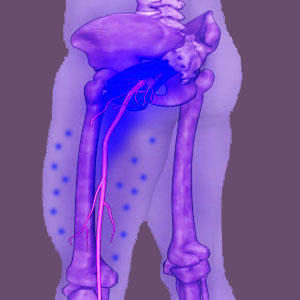
Piriformis numbness is not felt in the muscle itself, but instead results when the muscle clamps down on the sciatic or pudendal nerves. Numbness as a consequence of this compression can be felt in many different areas of the body including the feet, legs, groin, perineum and anus, depending on the specific circumstances of which tissue is compressed.
Numbness is not generally an initial symptom of piriformis syndrome. Instead, pain and tingling are more commonly experienced early in the expression, while numbness and weakness in affected areas of the body may follow later. In many patients, numbness will never occur, with pain being the main expression that endures over time in the affected bodily regions.
This essay explores why numbness may result in cases of piriformis sciatic and pudendal nerve compression. If you are experiencing numbness in the lower body in relation to a piriformis syndrome diagnosis, then this is the right discussion of you.
Piriformis Numbness Locations
When the sciatic nerve is compressed, numbness might be experienced in any area of the body served by this major neurological tissue. This includes anywhere in the legs or feet. Numbness might exist unilaterally or bilaterally, depending if both sides of the piriformis muscle are spasming or only one side.
If the pudendal nerve is compressed, symptoms will exist higher in the anatomy, typically in the groin, perineum, buttocks or genitals. Once again, symptoms might be limited to one side of the body in some cases or experienced bilaterally in others.
With piriformis syndrome diagnoses, there should be no symptoms existing above the level of compression, including back pain or abdominal pain. These types of numbness locations might indicate multiple origins of symptoms or misdiagnosis of the piriformis as the true source.
Numb Piriformis Expressions
Numbness can exist in subjective and objective forms. Subjective numbness describes symptoms wherein the affected area of the body feels heavy and lacking in sensation, but neurological evaluation will show normal or near normal nerve signal conductivity. In essence, feeling is diminished, but not lost. Objective numbness will show a lack of neurological impulse to the affected area, causing a true lack of sensation in the affected bodily location.
Numbness most often occurs in cases of severe compression of the affected nerve by the piriformis muscle due to chronic spasm. Numbness will often not result for some time, with tingling and pain being earlier expressions, then giving way to numbness and weakness over time. Many patients will not progress to experience numbness, but instead ill merely suffer pain and tingling in the affected areas chronically.
True objective numbness might also cause weakness of motor function and eventual dysfunction of certain bodily areas. Expressions like foot drop are not common in sciatic nerve compression versions of piriformis syndrome, but they are possible. Similarly, when the pudendal nerve is affected, numbness might exist in the saddle region and may even lead to such dramatic symptoms as incontinence of bladder and/or bowels or sexual dysfunction.
Piriformis Numbness Advisory
It is rare for piriformis compression of any nerve to result in objective numbness and weakness. It is possible, but extremely uncommon. In cases where these severe neurological expressions do exist, it is of paramount importance to be vigilant of possible misdiagnosis, since other causes of these symptoms might be serious, including diseases, systemic health issues and spinal pathology.
Similarly, if symptoms persist despite indicated care, then misdiagnosis is very likely. Remember that misdiagnosed piriformis pain is a big problem, since the expressions can mirror those of so many other diagnoses perfectly.
Know also that ischemia of the piriformis muscle is one of the leading causes of chronic spasming, instead of the usual theories of injury or imbalance to the muscular tissue. In these examples, the best course of action is to act on the underlying origin of spasms, which resides wholly in the mind, rather than in the muscle itself. Knowledge therapy will get the job done safely and effectively.





